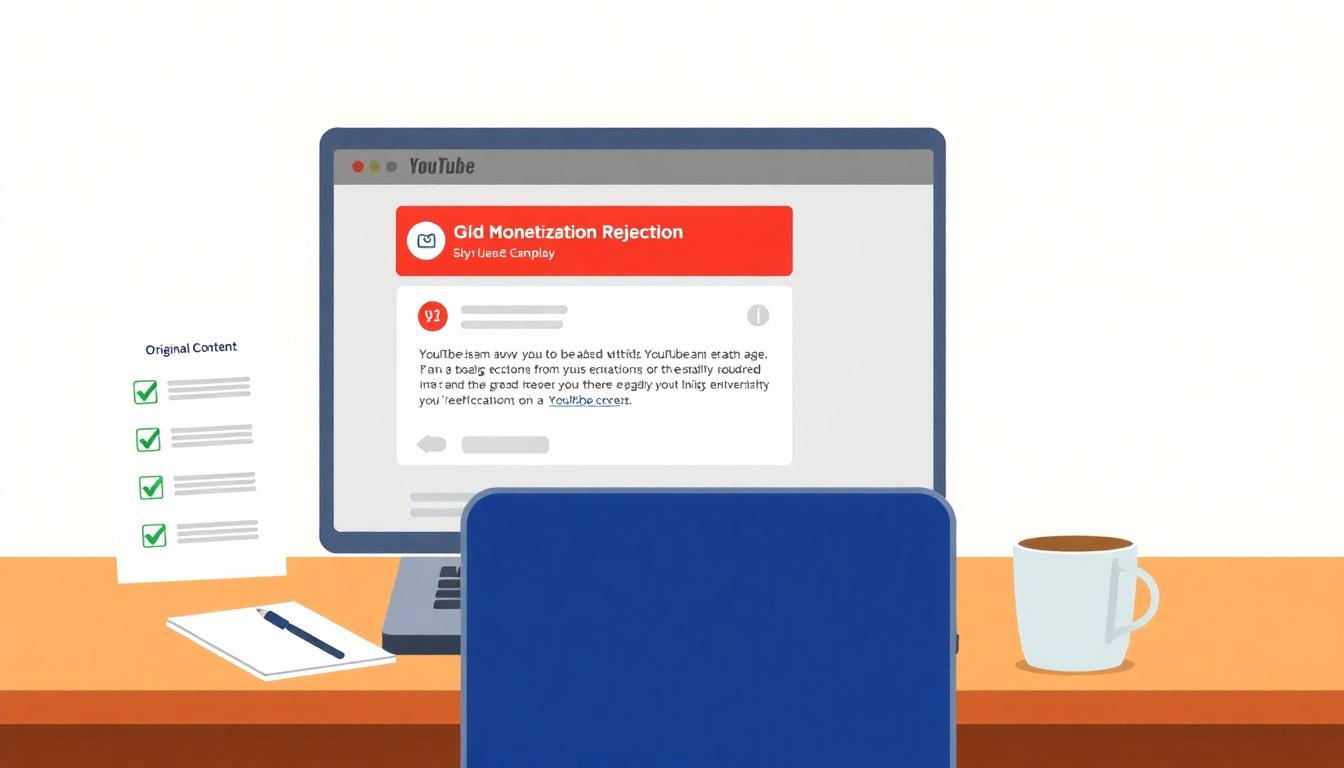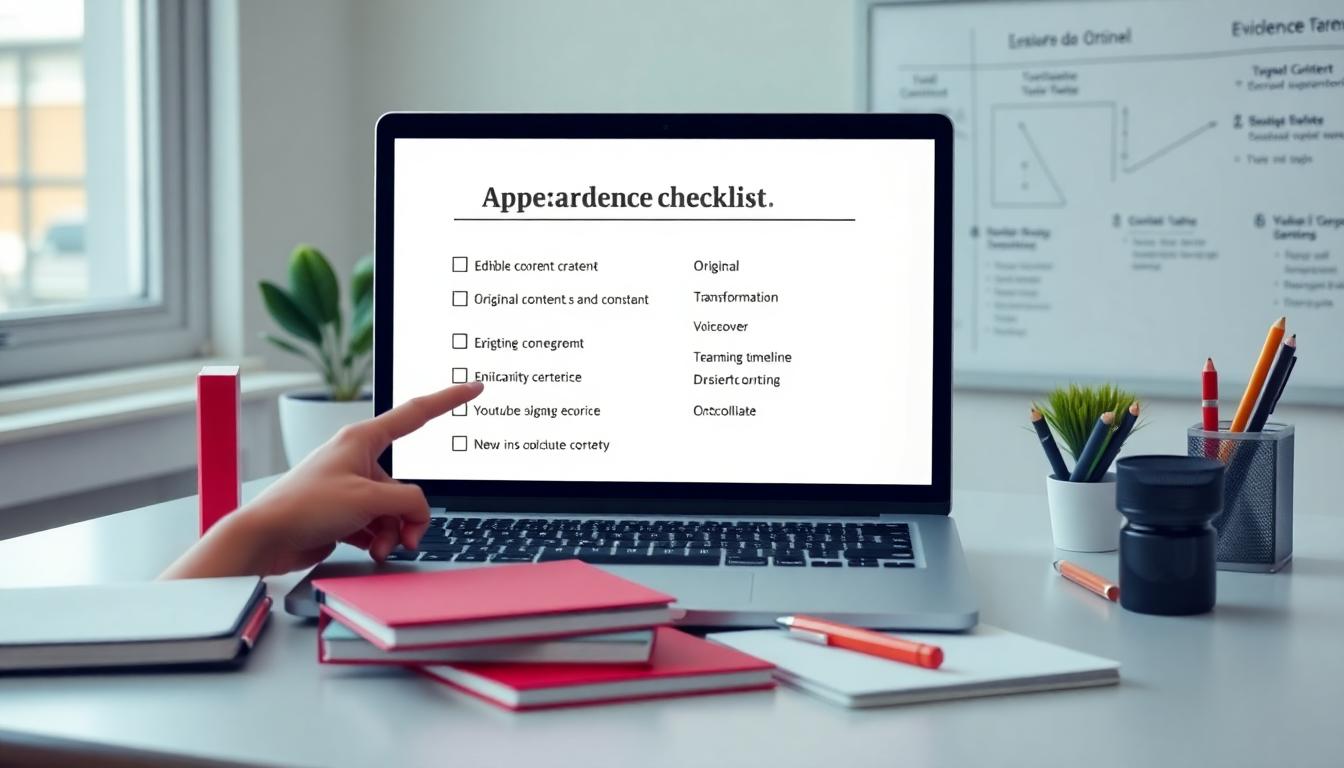How to Appeal a YouTube Monetization Rejection (With Email Templates and Proof Tips)
YouTube monetization lets creators earn money from their videos, but not everyone gets approved right away. Many channels face rejection due to strict policies around original content and guidelines. Appealing a rejection is essential because it gives you a chance to regain those valuable monetization benefits. This post will guide you through the appeal process, offering practical email templates and advice on how to gather the right evidence to support your case effectively.
By following simple steps and using clear examples, you can improve your chances of success and get your channel’s monetization back on track.
For a deeper look, here’s a helpful video on how to appeal YouTube monetization rejection, including tips for reused content cases:
https://www.youtube.com/watch?v=hXHzIgHvJDg
Understanding Why YouTube Monetization Rejections Happen
Getting a rejection on your YouTube monetization application can feel discouraging, especially when you're eager to grow your channel. Knowing why YouTube says no is key to making a strong appeal. YouTube has clear expectations about the kind of content they want to reward with ads, and they keep a tight check on authenticity and originality. Let's break down the most common reasons behind these rejections and what YouTube really looks for.
 Image showing a YouTube creator analyzing monetization rejection and evidence.
Image showing a YouTube creator analyzing monetization rejection and evidence.
One of the biggest reasons for rejection is reused content. This means the videos mostly show material from other creators or sources without enough original input from you. For example, uploading clips from movies, TV shows, or viral videos with minimal changes, like just adding a new title or thumbnail, often triggers this flag. YouTube’s rules require creators to add significant commentary, edits, or educational value to other people’s content. They want you to build your channel on your unique contributions rather than just recycling existing videos.
Inauthentic Content
In July 2025, YouTube renamed their "repetitious content" policy to focus more clearly on what they call inauthentic content. This goes beyond reused clips — it covers any mass-produced, low-effort content that looks like it was made quickly just to fill the platform. Think of this as “cookie-cutter” videos. YouTube flags channels that publish a lot of this type of content because it offers little value to viewers. Scenarios include repetitive slideshows, robotic voiceovers reading texts without any real insight, or multiple videos with near-identical content. To pass, your videos should be original, creative, and provide a genuine reason for viewers to watch.
Copyright and Policy Violations
Content that violates copyright is another common cause. YouTube’s system can detect unauthorized use of protected music, footage, or images. Even if you think your use falls under “fair use,” the automatic review can still result in rejection. More than copyrights, any breach of YouTube's Community Guidelines or Terms of Service — like harmful content or spam — also leads to monetization denial or removal. It’s essential to understand these policies well and make sure your channel content aligns with them to avoid hitting a wall.
YouTube’s Expectations for Original and Authentic Content
YouTube wants to promote channels that create original work that doesn’t just stack clips but adds real value. That means:
- You're either the creator of 100% of the content or you transform existing material significantly with your own voice, perspective, or editing.
- You avoid simply reposting content that others could claim ownership of.
- Your channel focus is clear, consistent, and engaging, showing you are invested in building a community or sharing knowledge.
This focus on originality helps YouTube keep advertisers confident that their ads appear alongside genuine content and not copies or low-quality videos.
How Reviewing the Rejection Email and Policies Helps
Your rejection email from YouTube usually includes a brief reason for why your channel didn't qualify this time. Reading this carefully is your first step. Sometimes the wording points directly to reused or inauthentic content issues, copyright strikes, or policy breaches.
Next, take time to study YouTube’s monetization policies. The official YouTube channel monetization policies cover everything from content requirements to community guidelines. Understanding these rules helps you pinpoint what needs fixing on your channel.
By combining insights from the rejection notice and guidelines, you can build a strong, focused appeal. You’ll show YouTube you understand the problem, you’re committed to meeting their standards, and you’ve taken clear steps to improve your content.
Establishing the core reasons behind a monetization rejection is your foundation for a winning appeal. Knowing what YouTube expects and why your channel fell short clears the way for making changes that get you approved next time.
For more details, you can visit YouTube’s official page on channel monetization policies to understand all requirements in depth.
Preparing Your Appeal: Key Evidence to Gather
If YouTube has rejected your monetization application, preparing your appeal with the right evidence is crucial. Think of this as building a clear and convincing story that proves your channel deserves the green light. Rather than just telling YouTube your content is original or valuable, you need to show it with solid proof. This section walks you through the essential types of evidence to collect and present.
Document Your Original Content Creation Process
Showing how you create your videos from start to finish can make a big difference. YouTube wants to see that your content isn’t just recycled clips but something crafted with your effort.
- Screen recordings or screencasts of your editing timeline highlight the work you put into video assembly and effects.
- Drafts and notes that track your planning and scriptwriting can back up your creative input.
- Examples of raw footage or original recordings show you source your own material.
These details prove the content is genuinely yours and not just copied or assembled from others.
Highlight Your Voiceovers or On-Screen Presence
Human involvement is key to passing monetization reviews. Voiceovers or appearing on camera demonstrate your active role in delivering the content.
- Use timestamps or clips that feature your narration explaining, reviewing, or adding unique insights.
- If you appear on video, screenshots or short clips showing your presence confirm that you are the creator.
- If your channel uses commentary, add examples where your voice adds context or analysis.
This helps convince YouTube your channel includes transformative, original contributions and isn’t just a collection of reused content.
Provide Evidence of Significant Content Transformation
If your channel includes reused content like game footage, reaction videos, or commentary on other materials, you must show how your work goes beyond mere reposting.
- Pinpoint moments of significant editing, remixing, or creative transformation.
- Share timestamps or edited clips where you add new value with analysis, humor, or storytelling.
- Provide a clear description of how your version differs from the original, focusing on your creative touch.
This underscores that your channel meets YouTube’s expectations by transforming existing content meaningfully.
Keep Your Channel and Videos Intact Until After Appeal
One mistake some creators make is deleting videos before submitting an appeal. Avoid this because YouTube reviews the channel as it is during their evaluation.
- Keeping videos posted maintains the full context and lets reviewers see your content history.
- Removing videos prematurely can signal to YouTube that your channel isn’t stable or trustworthy, reducing your chances.
Organize Your Evidence Clearly
When submitting your appeal, clarity is important. Put your evidence in a neat, easy-to-follow format.
- Use numbered lists or bullet points to itemize proof.
- Reference specific videos, timestamps, or clips to back your statements.
- Write simple, direct explanations highlighting your original work and contributions.
This helps your appeal stand out as focused and professional.

Image illustrating key evidence gathering for YouTube monetization appeal.
You can explore the official YouTube channel monetization policies for a detailed understanding of content requirements. This resource helps guide which types of evidence will best support your appeal and how to align your channel with YouTube’s standards.
Preparing your appeal with clear, detailed evidence shows YouTube that you take their guidelines seriously and have put real effort into making your channel original and valuable. This is the foundation for a successful monetization appeal.
Writing an Effective Appeal Email to YouTube
Responding to a YouTube monetization rejection by email requires a blend of clarity, professionalism, and respect. Your email acts as your direct line of communication with YouTube’s review team, so it needs to clearly reflect that you understand their policies and have made legitimate efforts to meet them. The key is to stay polite, specific, and factual while showing your willingness to comply. Below are two well-structured email templates tailored for different stages of monetization appeals.
Email Template for First-Time Monetization Rejection Appeal
If this is your first time facing a denial, the tone should express understanding and openness to feedback. You want to acknowledge YouTube's rules and demonstrate how your content genuinely adds value and originality. Here’s a simple, adaptable template for your first appeal:
Subject: Request for Re-Review of Monetization Application – [Your Channel Name]
Dear YouTube Partner Support Team,
I hope this message finds you well. I recently received the decision regarding my application for monetization on my channel, [Your Channel Name]. I understand that my channel was rejected due to concerns related to [specify the rejection reason, e.g., reused content].
I want to assure you that I have taken steps to create original and unique content that complies with YouTube’s monetization policies. I carefully review all guidelines and continuously strive to produce engaging videos that reflect my own work and creativity.
Please consider re-evaluating my channel. I am committed to maintaining compliance with YouTube’s Community Guidelines and Partner Program requirements. I would be grateful for the opportunity to have my application reviewed again.
Thank you very much for your time and consideration.
Best regards,
[Your Full Name]
[Your YouTube Channel Link]
[Your Contact Email]
This approach is courteous and demonstrates your respect for the process. It pinpoints the rejection reason, signals you've acted on it, and ends with a polite, humble request for reconsideration.
Email Template for Repeated Monetization Rejection Appeal
If your channel has faced multiple rejections, the email must be more detailed and assertive. You need to clearly show what you have changed since the last appeal, provide stronger evidence of originality, and reinforce that your content fully complies with policies. This email should reflect your progress and learning curve:
Subject: Follow-Up Appeal on Monetization Rejection – Updates on [Your Channel Name]
Dear YouTube Partner Support Team,
Thank you for reviewing my previous appeals regarding monetization for my channel, [Your Channel Name]. I appreciate the feedback that helped me improve my content.
Since the last decision, I have implemented several changes to ensure full compliance with YouTube’s monetization policies. These include:
- Creating 100% original content by [explain specific actions, e.g., filming all footage myself].
- Adding substantial commentary and educational value to any reused content.
- Removing or editing any videos flagged as reused or inauthentic.
- Conducting thorough reviews to comply with all Community Guidelines and Terms of Service.
I have attached links to some of my recent videos that clearly show these improvements:
- [Video Link 1] – Explanation of original content and transformation
- [Video Link 2] – Examples of my voiceover and commentary
I kindly request a thorough reconsideration of my channel’s monetization eligibility. I am committed to growing my channel responsibly and following YouTube’s rules.
Thank you for your continued time and support.
Sincerely,
[Your Full Name]
[Your YouTube Channel Link]
[Your Contact Email]
This kind of appeal highlights your efforts and adherence in detail and helps reviewers understand your side clearly. Including video links gives strong evidence right in the email, improving your chance of a positive response.

Image showing a creator writing an appeal email for YouTube monetization.
Writing your appeal email thoughtfully sends a strong signal to YouTube that you take their rules seriously and are eager to comply. For official details on YouTube monetization policies and appeals, you can visit the YouTube channel monetization policies page which explains criteria and guidelines in detail. For tips on the appeal process, this YouTube Partner Program suspension appeal guide also provides useful insights.
Being specific about the reason for rejection and showing real improvements will make your appeal stand out positively among many others.
What to Expect After Sending Your Appeal and Next Steps
After sending your appeal to YouTube regarding monetization rejection, it’s natural to wonder what happens next and how to proceed. Understanding the timeline and possible outcomes can keep you calm and prepared during this waiting period. YouTube aims to process appeals fairly but the process involves detailed reviews that take some time. Here’s what you should expect once your appeal is submitted and what steps to take afterward.
The Appeal Review Timeline
YouTube usually takes up to 14 days to review your monetization appeal. During this time, their team examines your entire channel, including recent changes and evidence you provided. This review isn’t instantaneous because the team must verify if your content now meets their monetization policies and standards.
- If you submitted a video appeal, reviewers check if it meets required criteria, such as clear explanations of content creation and policy adherence.
- Your channel is evaluated in its current state, so avoid deleting videos or making major content changes during this period.
- Sometimes decisions come earlier, but it’s best to expect the full 14 days before hearing back.
Possible Outcomes of the Appeal Review
Once the review completes, you’ll receive an email notifying you of YouTube’s decision. Here are the possible results:
- Approval or Re-approval: Your appeal was successful, and your channel will be monetized or restored to the Partner Program.
- Rejection: The appeal did not meet YouTube’s requirements. If this happens, ad monetization won’t be enabled.
- Request for More Information: Occasionally, YouTube might ask for additional details or evidence before finalizing their decision. If so, respond promptly and clearly to this request.
What to Do if Your Appeal Is Rejected
A rejection isn’t the end of the road. YouTube allows you to reapply, but there are waiting periods to keep in mind:
- After a first rejection, you must wait 30 days before submitting another application or appeal.
- For multiple rejections, the waiting period extends to 90 days before reapplying again.
Use this time wisely by improving your channel’s content quality and policy compliance.
Keep Improving Your Channel
While waiting or between appeals, focus on strengthening your channel:
- Create more original content with clear value to your audience.
- Add voiceovers, commentary, or educational insights that transform reused clips.
- Remove or edit any videos that could be considered reused or inauthentic content.
- Engage your audience with consistent, authentic uploads.
These ongoing efforts show YouTube that you’re committed to their guidelines and increase your chances of future approval.
Explore Alternative Monetization Strategies
Since YouTube’s monetization can be strict, consider diversifying your income sources for your channel:
- Use channel memberships, Super Thanks, and fan funding available through YouTube’s new entry-level monetization tier.
- Promote affiliate marketing, sponsored content, or merchandise.
- Build your presence on platforms like Patreon or Ko-fi for viewer support.
Maintaining a mix of revenue sources reduces reliance on YouTube ads alone while your appeal is pending or if it gets rejected.

Image showing a YouTube creator reviewing their monetization appeal status.
For detailed official information on YouTube’s appeal process and eligibility criteria, you can visit the YouTube Partner Program suspension appeal page. Understanding their policies fully will help you avoid mistakes and guide your next steps confidently.
Knowing the timeline and possible outcomes helps you stay prepared and strategic after sending an appeal. Use this time to improve your channel and explore other ways to monetize until YouTube responds.
Conclusion
Understanding why your YouTube monetization was rejected is the first step toward a successful appeal. Gather clear evidence that proves your content is original and adds value, such as editing workflows, voiceovers, and detailed explanations of your creative process. Use polite, straightforward email templates to communicate your improvements and willingness to comply with YouTube’s guidelines.
Patience is essential during the waiting period after submitting your appeal, as YouTube carefully reviews channels to enforce their updated "inauthentic content" policy that targets mass-produced or low-effort videos. Focus on creating authentic, distinctive content that truly reflects your voice and effort. Staying informed about these 2025 policy updates will help you adapt and improve your channel for long-term monetization success.
Keep pushing forward with originality and clear compliance. Your persistence and transparency are key to unlocking monetization on YouTube.















0 Comments:
Post a Comment